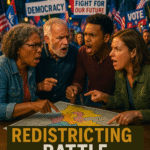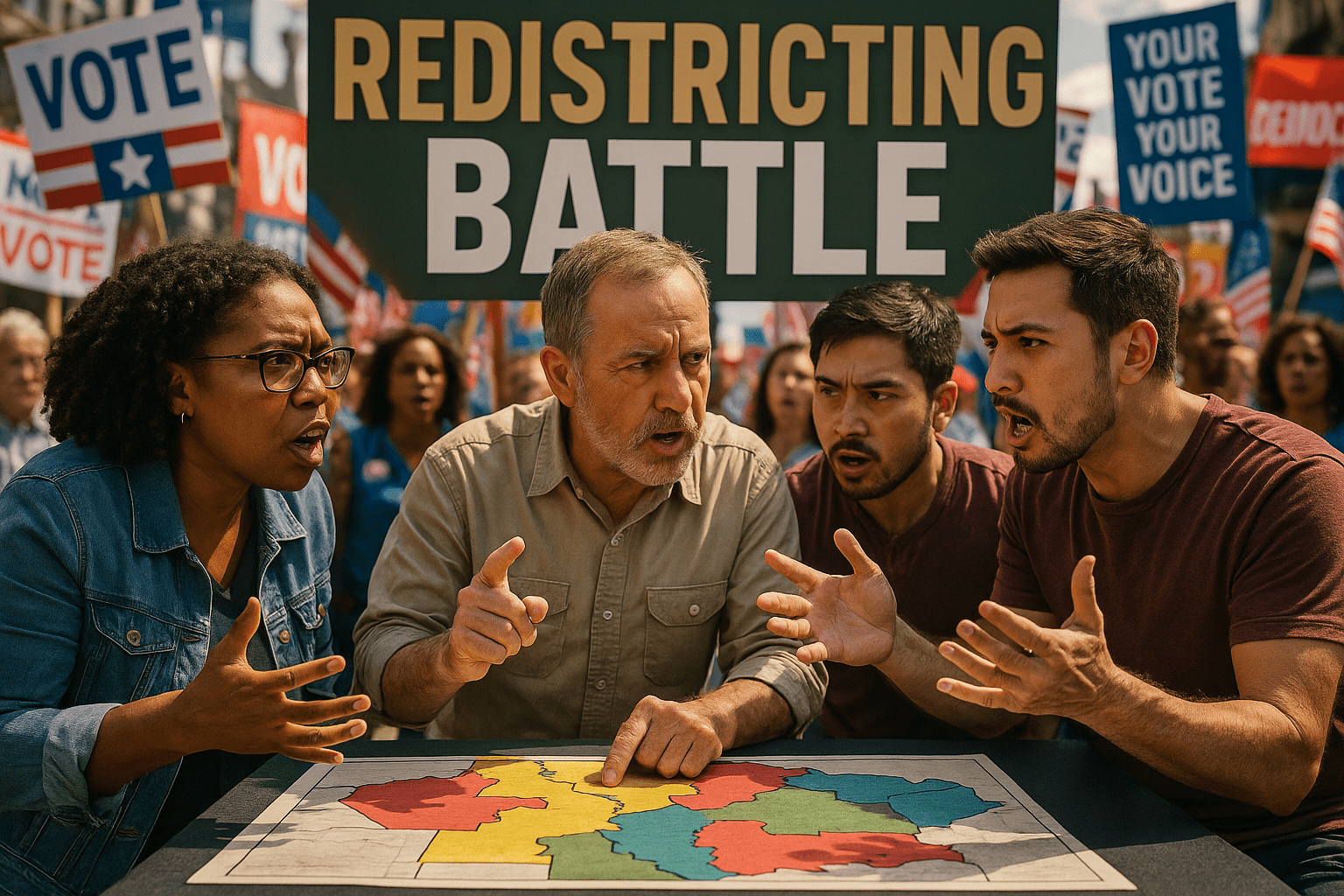

Redistricting: A National Power Play
By Darius Spearman (africanelements)
Support African Elements at patreon.com/africanelements and hear recent news in a single playlist. Additionally, you can gain early access to ad-free video content.
Redistricting: The Battle for Power
The political landscape of the United States is currently gripped by an intense struggle over redistricting, a process that determines the boundaries of electoral districts. This battle has escalated into a national phenomenon, with states like Texas and California at its epicenter. Former Attorney General Eric Holder is actively involved in strategizing with House Democrats to combat Republican-led redistricting efforts, particularly in Texas (sandhillsexpress.com). As the chairman of the National Democratic Redistricting Committee (NDRC), Holder provided a “high-level overview” to the House Democratic Caucus on the fight against what he termed “Donald Trump’s gerrymandering scheme in Texas and across the country” (sandhillsexpress.com).
The NDRC is an organization dedicated to combating partisan gerrymandering and promoting fair redistricting processes. Holder, in his role as chairman, guides its strategy and advocates for its goals. The NDRC aims to influence redistricting at the state level to create more equitable electoral maps, which can significantly impact the balance of power in the U.S. House of Representatives. Their involvement often includes legal challenges, public awareness campaigns, and supporting Democratic candidates in state-level elections that have a bearing on redistricting. Following Holder's call, the entire Democratic caucus is reportedly united against GOP redistricting attempts (sandhillsexpress.com). This coordinated effort highlights the high stakes involved in shaping the electoral map for future elections.
Understanding Gerrymandering
Gerrymandering: The practice of manipulating electoral district boundaries to favor one political party or group over another. This can be achieved by drawing districts in irregular shapes to concentrate opposing voters into a few districts (packing) or to spread them thinly across many districts (cracking), thereby diluting their voting power. The goal is to create a disproportionate number of “safe” seats for the favored party, making it difficult for the opposing party to win elections even if they have a significant share of the overall vote. Source: MDN
Texas: A Key Battleground
Texas has emerged as a central battleground in the national redistricting fight, with Republicans aiming to gain congressional seats. Texas GOP Governor Greg Abbott called a special session to consider a new congressional map designed to net a five-seat Republican majority (sandhillsexpress.com). The proposed map would add five House seats in districts that Donald Trump won by double digits in 2024. The Texas Senate passed the proposed map in a 19-2 vote, prompting many Democratic lawmakers to walk out in protest (sandhillsexpress.com).
Texas House Democrats fled the state to deny Republicans a quorum, preventing a vote on the map (sandhillsexpress.com). In a legislative body, a quorum refers to the minimum number of members who must be present for the body to legally conduct business, such as voting on bills or taking official action. This requirement is typically outlined in the legislative rules or constitution. When a group of legislators “walks out” or otherwise absents themselves to deny a quorum, they are intentionally preventing the legislative body from reaching the necessary number of members to proceed with a vote or other action. This tactic is often employed by the minority party to block legislation they oppose, as without a quorum, the majority party cannot pass bills, even if they have enough votes among the members who are present. Governor Abbott has vowed to call another special session if Democrats do not return before the current session ends on August 19th (sandhillsexpress.com; newyorker.com).
California's Counter-Measures
Democrats are responding to Texas's redistricting efforts with their own counter-measures, particularly in California. California Governor Gavin Newsom announced the “Election Rigging Response Act,” which would allow California voters to decide on new maps designed to offset Texas's proposed changes (bostonglobe.com). California will hold a special election on November 4th to seek voter approval of a new congressional map, which is a key part of their countermeasure strategy (ground.news). If approved by voters, California's state legislature would control electoral maps in 2026, 2028, and 2030, before control reverts to the state's independent commission (abcnews.go.com).
The Democratic Congressional Campaign Committee released the proposed California maps, and state lawmakers plan to hold hearings and vote on them (bostonglobe.com). California's state Senate Democratic leader, Mike McGuire, stated, “This is about more than drawing lines on a map. It’s about drawing a line in the sand to stop Texas and Trump from rigging the election” (bostonglobe.com). Independent redistricting commissions are non-partisan bodies established in some states to draw electoral district boundaries, aiming to remove the process from direct political control by state legislatures. The significance of sidelining such a commission, as California is considering, lies in the potential for partisan manipulation. When a state moves away from an independent commission to a legislative or voter-approved process, it raises concerns that the new maps will be drawn to benefit the dominant political party, undermining the commission's original intent of fair and non-partisan districting.
Mid-Decade Redistricting Explained
Mid-decade redistricting: The redrawing of electoral maps outside of the constitutionally mandated decennial census and subsequent redistricting cycle. Typically, congressional and state legislative districts are redrawn once every ten years following the U.S. Census to reflect population shifts. Mid-decade redistricting is controversial because it is often initiated for partisan advantage, allowing the party in power to redraw maps to solidify their control or gain seats, rather than to address genuine demographic changes. This can be seen as an attempt to circumvent the established, less partisan process and is often met with legal challenges and accusations of political opportunism. Source: MDN
The National Implications
The redistricting battle is expanding beyond Texas and California, with other states considering similar actions. New York's state legislature has introduced a bill that would allow it to trigger mid-decade redistricting if another state does so first (newyorker.com). Ohio is currently redrawing its electoral maps (newyorker.com). Furthermore, officials in Florida and Missouri have publicly stated their intent to join the redistricting fray (newyorker.com).
The redistricting battles in Texas and California have significant national implications because they directly impact the partisan composition of the U.S. House of Representatives. Texas, a rapidly growing state, is gaining congressional seats, and how its districts are drawn can determine whether those new seats favor Republicans or Democrats. Similarly, California, a Democratic stronghold, is attempting to redraw its maps to potentially gain additional Democratic seats. Given the current narrow Republican majority in the House (219-212 with four vacancies), even a few seat changes in these large states could shift the balance of power, influencing which party controls the House and, consequently, the legislative agenda and ability to pass or block presidential initiatives. This creates a national “turf war” where both parties are strategically maneuvering to maximize their congressional representation. Maryland has only a single seat to flip, and Illinois, where congressional maps already heavily favor Democrats, is unlikely to yield many more (newyorker.com).
Democratic Strategy and Public Support
The Democratic strategy involves both legislative action and public support to counter Republican redistricting. Former President Barack Obama has rallied support for Texas Democrats who left the state to block the GOP redistricting plan (abcnews.go.com). California Democrats are seeking voter consent for midterm redistricting in 2026, 2028, and 2030 to respond to the situation in Texas and “level the playing field all across the United States” (abcnews.go.com).
Governor Newsom has urged Donald Trump to abandon the redistricting fight, calling for an end to the partisan brawl (hendersondispatch.com). Public opinion and voter engagement are crucial for the success or failure of redistricting efforts, especially when they involve direct voter approval, as in California. While the data mentions the need for voter consent in California, it lacks details on the level of public awareness about the proposed changes, whether voters generally support or oppose the idea of redrawing maps for partisan reasons, or how engaged they are in the issue. Public sentiment can significantly influence the outcome of the special election and the political viability of the new maps, as strong opposition could lead to their rejection or fuel legal challenges.
Impact on Voters of Color and Legal Challenges
Concerns about diluting the voting power of people of color in redistricting often arise when new district lines are drawn in a way that fragments minority communities across multiple districts or packs them into a single district with an overwhelming majority, thereby reducing their ability to elect candidates of their choice. This can violate the Voting Rights Act. The Voting Rights Act of 1965 (VRA) is a landmark piece of federal legislation in the United States that prohibits racial discrimination in voting. It aims to protect the voting rights of racial minorities by outlawing discriminatory voting practices adopted in many Southern states after the Civil War, including literacy tests and poll taxes. In the context of redistricting, the VRA prohibits drawing district lines in a way that dilutes the voting power of racial or language minority groups.
Legal challenges are a common and often inevitable aspect of redistricting disputes, especially when maps are perceived as being drawn for partisan advantage or to dilute minority voting power. While the provided data does not detail specific ongoing lawsuits, it does indicate that some people have already stated they would sue over California's proposed changes (bostonglobe.com). This strongly suggests that court challenges are anticipated. Such lawsuits typically argue that the new maps violate state or federal laws, such as the Voting Rights Act, or constitutional principles like equal protection. The outcome of these legal battles can significantly alter the final district boundaries and the political landscape. A federal ban on partisan gerrymandering, if enacted, would prohibit drawing district lines specifically to favor one political party over another. This would significantly impact redistricting by requiring states to create maps that are more politically neutral, potentially leading to more competitive elections and a more representative Congress.
Potential Impact on House Control
The Road Ahead
The timeline for these redistricting battles varies by state. California will hold a special election on November 4th for voter approval of new maps, indicating a clear next step for California's redistricting efforts (ground.news). However, for Texas, if no agreement is reached by the special session end date of August 19th, the process could face several outcomes. It might lead to further special sessions, legal challenges that could force court-drawn maps, or the existing maps remaining in place until the next regular redistricting cycle, depending on state law and court rulings. The lack of an agreement often prolongs the political and legal uncertainty surrounding district boundaries.
The technical aspects of map drawing involve complex demographic data, geographic information systems (GIS), and adherence to various legal criteria. Maps are typically drawn using population data from the U.S. Census to ensure districts have roughly equal populations, as required by the “one person, one vote” principle. Other criteria often include contiguity (districts must be unbroken), compactness (districts should not be oddly shaped), and respect for communities of interest (keeping neighborhoods or groups with shared interests together). Partisan advantage is measured by analyzing voting patterns, demographic data, and election results to predict how different district configurations will impact the likelihood of a particular party winning. This can involve sophisticated algorithms and simulations to maximize the number of “safe” seats for one party or to dilute the strength of the opposing party. Understanding these technicalities helps clarify how subtle changes in lines can have profound political consequences.
ABOUT THE AUTHOR
Darius Spearman has been a professor of Black Studies at San Diego City College since 2007. He is the author of several books, including Between The Color Lines: A History of African Americans on the California Frontier Through 1890. You can visit Darius online at africanelements.org.
